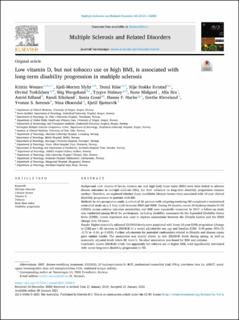| dc.contributor.author | Wesnes, Kristin | |
| dc.contributor.author | Myhr, Kjell-Morten | |
| dc.contributor.author | Riise, Trond | |
| dc.contributor.author | Stokke, Silje Agnethe | |
| dc.contributor.author | Torkildsen, Øivind | |
| dc.contributor.author | Wergeland, Stig | |
| dc.contributor.author | Holmøy, Trygve | |
| dc.contributor.author | Midgard, Rune | |
| dc.contributor.author | Bru, Alla Nikolajevna S | |
| dc.contributor.author | Edland, Astrid | |
| dc.contributor.author | Eikeland, Randi | |
| dc.contributor.author | Gosal, Sonia | |
| dc.contributor.author | Harbo, Hanne Flinstad | |
| dc.contributor.author | Kleveland, Grethe | |
| dc.contributor.author | Sørenes, Yvonne | |
| dc.contributor.author | Øksendal, Nina | |
| dc.contributor.author | Bjørnevik, Kjetil Lauvland | |
| dc.date.accessioned | 2021-05-28T12:38:28Z | |
| dc.date.available | 2021-05-28T12:38:28Z | |
| dc.date.created | 2021-04-29T09:39:45Z | |
| dc.date.issued | 2021 | |
| dc.identifier.issn | 2211-0348 | |
| dc.identifier.uri | https://hdl.handle.net/11250/2756906 | |
| dc.description.abstract | Background: Low vitamin D levels, tobacco use and high body mass index (BMI) have been linked to adverse disease outcomes in multiple sclerosis (MS), but their influence on long-term disability progression remains unclear. Therefore, we explored whether these modifiable lifestyle factors were associated with 10-year clinical disability progression in patients with MS. Methods: In this prospective study, a cohort of 88 patients with relapsing-remitting MS completed a randomized controlled study on ω-3 fatty acids between 2004 and 2008. During 24 months, serum 25-hydroxyvitamin D (25 (OH)D), serum cotinine (nicotine metabolite), and BMI were repeatedly measured. In 2017, a follow-up study was conducted among 80 of the participants, including disability assessment by the Expanded Disability Status Scale (EDSS). Linear regression was used to explore associations between the lifestyle factors and the EDSS change over 10 years. Results: Higher seasonally adjusted 25(OH)D levels were associated with lower 10-year EDSS progression (change in EDSS per 1 SD increase in 25(OH)D in a model adjusted for sex, age and baseline EDSS: -0.45 point, 95% CI: -0.75 to -0.16, p=0.003). Further adjustments for potential confounders related to lifestyle and disease status gave similar results. The association was mainly driven by low 25(OH)D levels during spring, as well as seasonally adjusted levels below 80 nmol/L. No clear association was found for BMI and cotinine. Conclusion: Lower 25(OH)D levels, but apparently not tobacco use or higher BMI, were significantly associated with worse long-term disability progression in MS. | en_US |
| dc.language.iso | eng | en_US |
| dc.publisher | Elsevier | en_US |
| dc.rights | Navngivelse 4.0 Internasjonal | * |
| dc.rights.uri | http://creativecommons.org/licenses/by/4.0/deed.no | * |
| dc.title | Low vitamin D, but not tobacco use or high BMI, is associated with long-term disability progression in multiple sclerosis | en_US |
| dc.type | Journal article | en_US |
| dc.type | Peer reviewed | en_US |
| dc.description.version | publishedVersion | en_US |
| dc.rights.holder | Copyright 2021 the authors. | en_US |
| dc.source.articlenumber | 102801 | en_US |
| cristin.ispublished | true | |
| cristin.fulltext | original | |
| cristin.qualitycode | 1 | |
| dc.identifier.doi | 10.1016/j.msard.2021.102801 | |
| dc.identifier.cristin | 1907135 | |
| dc.source.journal | Multiple Sclerosis and Related Disorders | en_US |
| dc.identifier.citation | Multiple Sclerosis and Related Disorders. 2021, 50, 102801. | en_US |
| dc.source.volume | 50 | en_US |

